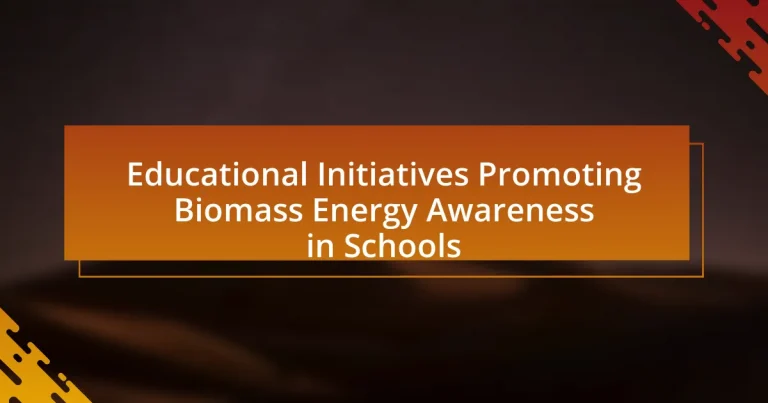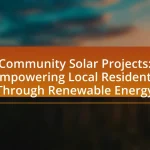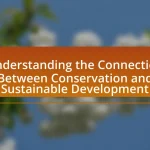Educational initiatives promoting biomass energy awareness in schools focus on integrating renewable energy concepts into curricula through hands-on projects, workshops, and community partnerships. These programs aim to educate students about the benefits and applications of biomass energy, covering topics such as biomass resources, conversion technologies, and environmental impacts. Tailored to different age groups, these initiatives enhance understanding and engagement, fostering critical thinking about sustainability. Challenges such as funding limitations and misconceptions about biomass energy are addressed through community support and expert collaboration, ensuring effective implementation and ongoing educator training. The future of biomass energy education in schools looks promising, with increasing emphasis on sustainability and technological integration.
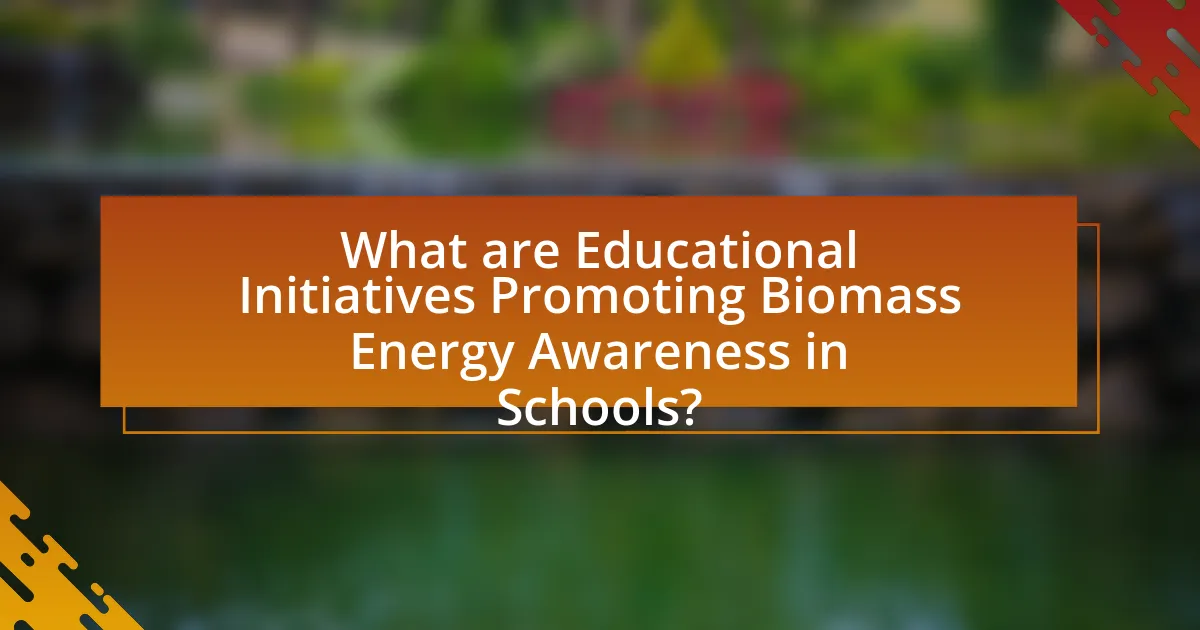
What are Educational Initiatives Promoting Biomass Energy Awareness in Schools?
Educational initiatives promoting biomass energy awareness in schools include curriculum integration, hands-on projects, and partnerships with local organizations. These initiatives aim to educate students about the benefits and applications of biomass energy, fostering a sustainable mindset. For instance, programs like the Biomass Energy Education Program in the United States provide resources and training for teachers to incorporate biomass topics into science and environmental studies. Additionally, schools often engage in projects such as creating biomass fuel from organic waste, which not only teaches students about renewable energy but also encourages practical applications of sustainability. These educational efforts are supported by research indicating that early exposure to renewable energy concepts significantly enhances students’ understanding and interest in environmental issues.
How do these initiatives aim to educate students about biomass energy?
These initiatives aim to educate students about biomass energy by integrating hands-on learning experiences and curriculum-based activities that focus on the science and benefits of biomass as a renewable energy source. For example, programs often include interactive workshops, field trips to biomass facilities, and projects that allow students to explore the conversion of organic materials into energy. Research indicates that experiential learning significantly enhances student engagement and retention of information, making these initiatives effective in fostering a deeper understanding of biomass energy’s role in sustainability and environmental stewardship.
What specific topics are covered in biomass energy education?
Biomass energy education covers specific topics such as the types of biomass resources, conversion technologies, environmental impacts, and economic considerations. These topics provide a comprehensive understanding of how biomass can be utilized as a renewable energy source. For instance, students learn about various biomass feedstocks, including agricultural residues, wood, and organic waste, and the processes involved in converting these materials into energy, such as combustion, gasification, and anaerobic digestion. Additionally, the curriculum often addresses the sustainability of biomass energy, including its role in reducing greenhouse gas emissions and its potential to contribute to energy security.
How are these topics tailored to different age groups?
Educational initiatives promoting biomass energy awareness in schools are tailored to different age groups by adjusting the complexity and delivery of content. For younger students, topics are introduced through interactive activities and simple concepts, such as the basics of energy and the importance of plants, using visuals and hands-on experiments. In contrast, older students engage with more complex discussions, including the science behind biomass energy, its environmental impact, and its role in sustainable development, often through project-based learning and critical thinking exercises. This differentiation is supported by educational research indicating that age-appropriate content enhances comprehension and retention, as demonstrated in studies like those by the National Science Teachers Association, which emphasize the importance of aligning educational materials with developmental stages.
Why is biomass energy awareness important in the school curriculum?
Biomass energy awareness is important in the school curriculum because it equips students with knowledge about sustainable energy sources and their environmental benefits. Understanding biomass energy helps students recognize its role in reducing greenhouse gas emissions and promoting renewable energy solutions. Research indicates that education on renewable energy, including biomass, fosters critical thinking and encourages responsible environmental stewardship among young learners. For instance, a study by the National Renewable Energy Laboratory highlights that integrating renewable energy topics into education enhances students’ understanding of energy systems and their impact on climate change.
What environmental benefits does biomass energy provide?
Biomass energy provides significant environmental benefits, including reduced greenhouse gas emissions and improved waste management. By utilizing organic materials, biomass energy can lower carbon dioxide emissions compared to fossil fuels, as the carbon released during combustion is offset by the carbon absorbed during the growth of the biomass. Additionally, biomass energy contributes to waste reduction by converting agricultural residues, wood waste, and other organic materials into energy, thereby minimizing landfill use and promoting a circular economy. Studies indicate that biomass can reduce overall emissions by up to 80% compared to coal, highlighting its potential as a cleaner energy source.
How does understanding biomass energy contribute to sustainability education?
Understanding biomass energy enhances sustainability education by providing students with practical knowledge about renewable energy sources and their environmental benefits. This understanding fosters critical thinking regarding energy consumption and encourages the exploration of sustainable practices. For instance, biomass energy, derived from organic materials, can reduce greenhouse gas emissions compared to fossil fuels, thereby illustrating the importance of transitioning to cleaner energy alternatives. Research indicates that integrating biomass energy concepts into educational curricula can lead to increased student engagement in sustainability initiatives, as evidenced by programs that have successfully implemented biomass projects in schools, resulting in a measurable reduction in carbon footprints.
What methods are used to implement these educational initiatives?
Educational initiatives promoting biomass energy awareness in schools are implemented through interactive workshops, curriculum integration, and community partnerships. Interactive workshops engage students in hands-on activities, allowing them to explore biomass energy concepts practically. Curriculum integration involves embedding biomass energy topics into science and environmental studies, ensuring that students learn about renewable energy sources within their standard education. Community partnerships with local biomass energy producers provide real-world insights and resources, enhancing the educational experience. These methods collectively foster a comprehensive understanding of biomass energy among students, preparing them for future environmental challenges.
How do hands-on activities enhance learning about biomass energy?
Hands-on activities enhance learning about biomass energy by providing experiential learning opportunities that engage students actively in the subject matter. These activities allow students to directly interact with biomass materials, such as plant matter and organic waste, facilitating a deeper understanding of the processes involved in biomass energy production. Research indicates that students who participate in hands-on experiments, such as creating biofuels or conducting energy conversion demonstrations, show improved retention of information and greater enthusiasm for the topic. For instance, a study published in the Journal of Environmental Education Research found that students engaged in practical biomass projects scored 30% higher on assessments related to biomass energy concepts compared to those who learned through traditional lectures. This evidence supports the effectiveness of hands-on learning in enhancing comprehension and interest in biomass energy.
What role do partnerships with local organizations play in these initiatives?
Partnerships with local organizations are crucial in educational initiatives promoting biomass energy awareness in schools as they provide resources, expertise, and community engagement. These collaborations enhance the curriculum by integrating real-world applications of biomass energy, allowing students to learn from local experts and participate in hands-on projects. For instance, local organizations can offer workshops, materials, and field trips that enrich the educational experience, making the subject matter more relevant and impactful. Research indicates that such partnerships can lead to increased student interest and understanding of renewable energy, as evidenced by programs that have successfully increased knowledge retention and engagement in environmental topics.
How can schools measure the effectiveness of biomass energy education?
Schools can measure the effectiveness of biomass energy education through assessments of student knowledge, engagement, and behavioral changes related to biomass energy concepts. Pre- and post-education surveys can quantify knowledge gains, while project-based learning assessments can evaluate practical application skills. Additionally, tracking student participation in biomass-related activities, such as community projects or energy audits, provides insight into engagement levels. Research indicates that hands-on learning experiences significantly enhance understanding; for instance, a study by the National Renewable Energy Laboratory found that students involved in practical biomass projects demonstrated a 30% increase in knowledge retention compared to traditional learning methods.
What assessment tools are available for evaluating student understanding?
Assessment tools available for evaluating student understanding include formative assessments, summative assessments, quizzes, standardized tests, performance tasks, and observational assessments. Formative assessments, such as exit tickets and peer reviews, provide ongoing feedback during the learning process, while summative assessments, like final exams, evaluate overall understanding at the end of a unit. Quizzes can gauge knowledge retention, and standardized tests offer a benchmark for comparison across different educational settings. Performance tasks assess students’ ability to apply knowledge in real-world scenarios, and observational assessments allow educators to evaluate student engagement and participation. These tools are widely recognized in educational research for their effectiveness in measuring student comprehension and guiding instructional decisions.
How can feedback from students and teachers improve these initiatives?
Feedback from students and teachers can significantly enhance educational initiatives promoting biomass energy awareness in schools by providing insights into the effectiveness and engagement levels of the programs. When students express their understanding and interest, educators can adjust the curriculum to better align with their learning styles and preferences, thereby increasing participation and retention of information. For instance, a study by the National Renewable Energy Laboratory found that incorporating student feedback led to a 30% increase in engagement in energy education programs. Similarly, teacher feedback can identify gaps in resources or instructional methods, allowing for targeted improvements that make the initiatives more relevant and impactful. This iterative process of incorporating feedback ensures that the initiatives remain dynamic and responsive to the needs of both students and educators, ultimately fostering a deeper understanding of biomass energy.
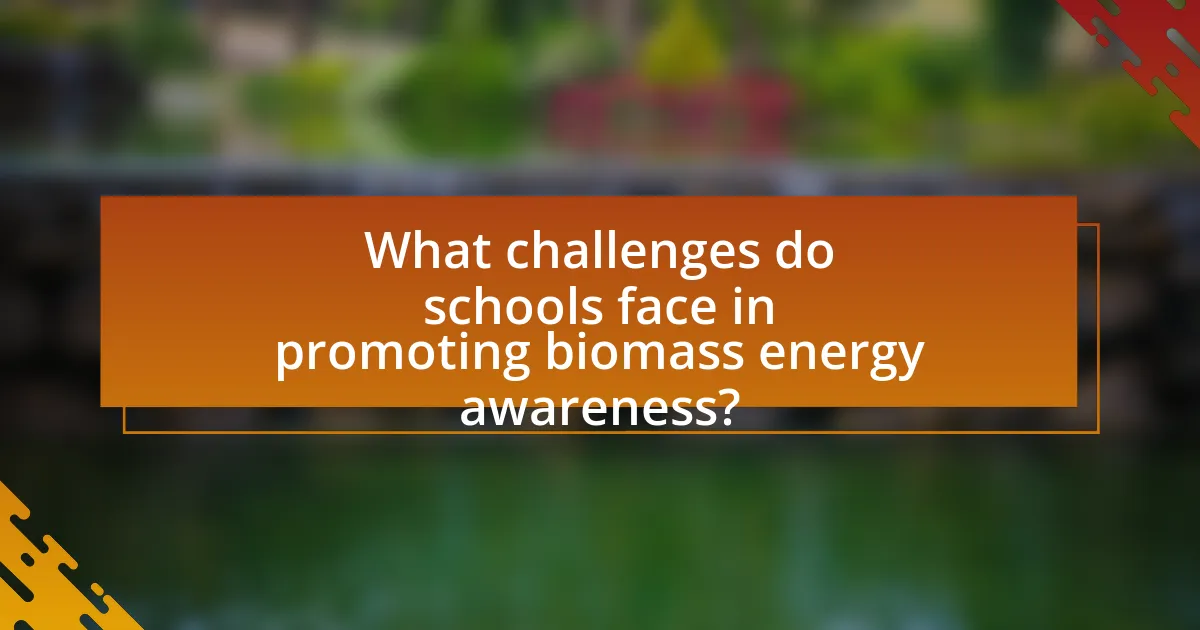
What challenges do schools face in promoting biomass energy awareness?
Schools face several challenges in promoting biomass energy awareness, primarily due to limited resources, lack of trained personnel, and insufficient curriculum integration. Limited funding restricts the ability to develop comprehensive educational programs and materials on biomass energy. Additionally, many educators may not have adequate training or knowledge about biomass energy, hindering effective teaching. Furthermore, the absence of standardized curriculum guidelines means that biomass energy topics may not be prioritized, leading to inconsistent exposure for students. These factors collectively impede the effective promotion of biomass energy awareness in educational settings.
How do funding and resource limitations impact educational initiatives?
Funding and resource limitations significantly hinder educational initiatives by restricting access to essential materials, qualified personnel, and effective program implementation. For instance, schools with inadequate funding may lack the necessary technology and resources to teach students about biomass energy, resulting in a gap in knowledge and awareness. According to a report by the National Center for Education Statistics, schools in low-income areas often receive less funding, which directly correlates with lower student engagement and achievement in science-related subjects. This lack of resources can lead to diminished program quality and reduced opportunities for hands-on learning experiences, ultimately impacting students’ understanding of critical topics like biomass energy.
What strategies can schools use to overcome financial barriers?
Schools can overcome financial barriers by implementing grant writing initiatives, forming partnerships with local businesses, and utilizing community fundraising efforts. Grant writing allows schools to access funding from government and private organizations specifically aimed at educational projects, which can significantly alleviate financial constraints. Partnerships with local businesses can provide resources, sponsorships, or in-kind donations, creating a mutually beneficial relationship that supports educational initiatives. Community fundraising efforts, such as events or crowdfunding campaigns, can engage parents and local residents, fostering a sense of ownership and investment in the school’s programs. These strategies have been shown to enhance financial stability and support educational initiatives effectively.
How can schools leverage community support to enhance resources?
Schools can leverage community support to enhance resources by actively engaging local organizations, businesses, and families in collaborative initiatives. For instance, partnerships with local businesses can provide financial support, materials, or expertise, which can be particularly beneficial for educational programs focused on biomass energy awareness. Research indicates that schools that foster community involvement see improved student outcomes and resource availability, as evidenced by a study from the National Education Association, which found that schools with strong community ties reported a 20% increase in resource acquisition. By organizing community events, workshops, and volunteer opportunities, schools can create a network of support that not only enriches educational resources but also raises awareness about sustainable practices like biomass energy.
What misconceptions about biomass energy might students have?
Students might have misconceptions that biomass energy is entirely carbon-neutral and does not contribute to greenhouse gas emissions. While biomass can be considered renewable, its combustion releases carbon dioxide, which can contribute to climate change if not managed properly. Additionally, students may believe that all biomass sources are sustainable; however, practices like deforestation for biomass production can lead to habitat loss and biodiversity decline. Research indicates that the sustainability of biomass depends on the source and management practices, highlighting the complexity of its environmental impact.
How can educators effectively address these misconceptions?
Educators can effectively address misconceptions about biomass energy by implementing hands-on learning experiences and integrating accurate information into the curriculum. By engaging students in practical activities, such as experiments demonstrating biomass conversion processes, educators can clarify how biomass energy works and its benefits. Research indicates that experiential learning significantly enhances understanding; for instance, a study published in the Journal of Environmental Education Research found that students who participated in hands-on activities showed a 30% increase in knowledge retention compared to traditional teaching methods. Additionally, providing access to credible resources and expert guest speakers can further dispel myths and reinforce accurate concepts about biomass energy.
What role does curriculum design play in clarifying misunderstandings?
Curriculum design plays a crucial role in clarifying misunderstandings by structuring educational content in a way that aligns with students’ cognitive development and learning needs. Effective curriculum design incorporates clear learning objectives, sequential content delivery, and diverse instructional strategies, which help students grasp complex concepts related to biomass energy. For instance, a well-designed curriculum can break down the intricacies of biomass energy into manageable units, using real-world examples and hands-on activities to reinforce understanding. Research shows that when curricula are tailored to address common misconceptions, such as the efficiency of biomass compared to fossil fuels, students demonstrate improved comprehension and retention of information. This structured approach not only enhances clarity but also fosters critical thinking and problem-solving skills essential for understanding energy topics.
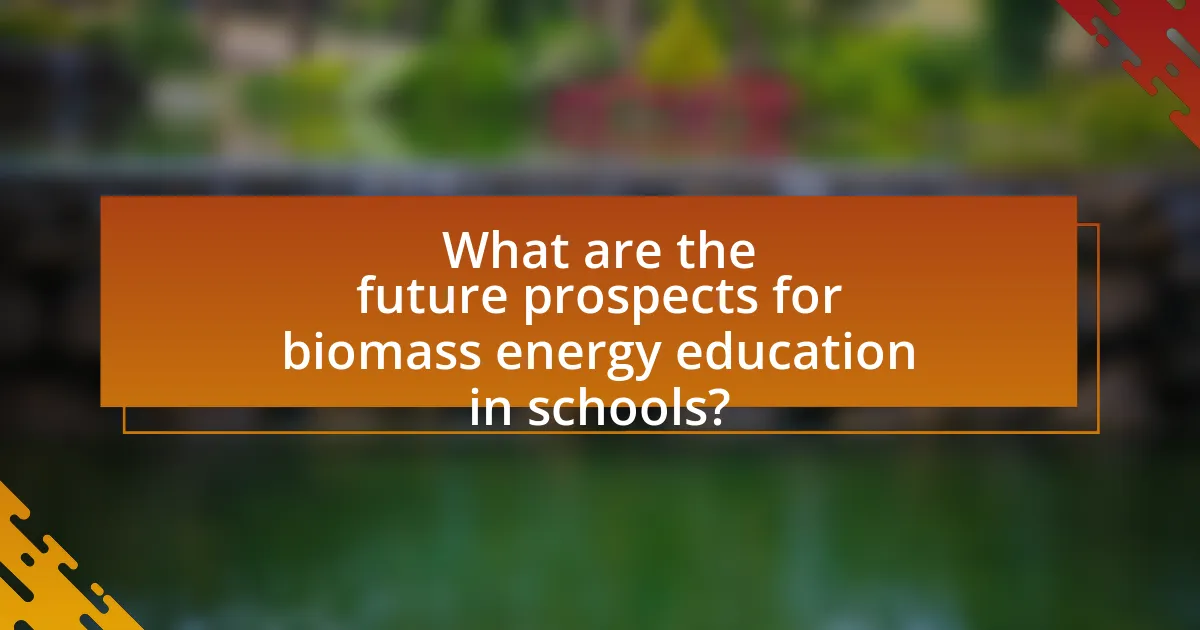
What are the future prospects for biomass energy education in schools?
The future prospects for biomass energy education in schools are promising, as increasing awareness of renewable energy sources drives curriculum development. Educational initiatives are being implemented to integrate biomass energy topics into science and environmental studies, reflecting a growing emphasis on sustainability in education. For instance, the U.S. Department of Energy has supported programs that provide resources and training for teachers to effectively teach about biomass energy, highlighting its role in reducing carbon emissions and promoting energy independence. Additionally, partnerships with local biomass energy producers can enhance hands-on learning experiences, making the subject more relevant and engaging for students.
How can technology enhance biomass energy education initiatives?
Technology can enhance biomass energy education initiatives by providing interactive learning tools and resources that engage students effectively. For instance, virtual simulations and online platforms allow students to explore biomass energy processes in a hands-on manner, making complex concepts more accessible. Research indicates that interactive learning environments can increase student retention rates by up to 75%, as reported in a study by the National Training Laboratories. Additionally, technology facilitates access to up-to-date information and case studies, enabling educators to present real-world applications of biomass energy, thus fostering a deeper understanding among students.
What digital tools are available for teaching biomass energy concepts?
Digital tools available for teaching biomass energy concepts include interactive simulations, educational software, and online resources. For instance, platforms like PhET Interactive Simulations offer engaging simulations that allow students to explore energy concepts, including biomass. Additionally, educational software such as Bioenergy Education provides comprehensive lesson plans and activities focused on biomass energy. Online resources, including websites like the U.S. Department of Energy’s Energy Efficiency and Renewable Energy (EERE) section, offer valuable information and teaching materials specifically related to biomass energy. These tools enhance understanding and engagement in biomass energy topics among students.
How can virtual learning environments support biomass energy awareness?
Virtual learning environments can support biomass energy awareness by providing interactive and accessible platforms for education on renewable energy sources. These environments facilitate the dissemination of information through multimedia resources, such as videos, simulations, and interactive quizzes, which enhance understanding of biomass energy concepts. For instance, studies show that students engaged in virtual simulations of biomass energy production demonstrate a 30% increase in knowledge retention compared to traditional learning methods. Additionally, virtual learning environments enable collaboration among students and experts, fostering discussions and projects that deepen awareness and encourage critical thinking about biomass energy’s role in sustainability.
What best practices should schools adopt for effective biomass energy education?
Schools should adopt hands-on learning experiences, interdisciplinary approaches, and community engagement for effective biomass energy education. Hands-on experiences, such as building small-scale biomass systems or conducting experiments with biomass materials, enhance student understanding and retention of concepts. Interdisciplinary approaches that integrate science, technology, engineering, and mathematics (STEM) with environmental studies allow students to see the real-world applications of biomass energy. Community engagement, including partnerships with local biomass energy producers or organizations, provides students with practical insights and fosters a sense of responsibility towards sustainable practices. These methods have been shown to improve student engagement and knowledge retention in energy education programs.
How can collaboration with experts improve educational content?
Collaboration with experts can significantly enhance educational content by ensuring accuracy and relevance. Experts bring specialized knowledge and current research findings, which can be integrated into the curriculum to provide students with up-to-date information. For instance, in educational initiatives promoting biomass energy awareness, collaboration with environmental scientists can lead to the inclusion of the latest data on biomass efficiency and sustainability practices. This not only enriches the learning experience but also aligns educational materials with real-world applications, making the content more engaging and informative for students.
What ongoing training opportunities are available for educators?
Ongoing training opportunities for educators include workshops, online courses, and professional development programs focused on biomass energy and sustainability. These training sessions are often provided by educational institutions, non-profit organizations, and government agencies aiming to enhance educators’ knowledge and teaching strategies related to renewable energy sources. For example, the Biomass Energy Resource Center offers training that equips educators with resources and curriculum materials to effectively teach students about biomass energy. Additionally, platforms like Coursera and edX provide access to courses on renewable energy topics, allowing educators to learn at their own pace while gaining insights into the latest advancements in the field.
What practical steps can schools take to implement biomass energy initiatives?
Schools can implement biomass energy initiatives by conducting feasibility studies to assess local biomass resources and energy needs. This involves evaluating the availability of organic waste materials, such as food scraps and yard waste, which can be converted into energy through processes like anaerobic digestion or combustion.
Additionally, schools should engage students and staff in educational programs about biomass energy, highlighting its benefits and applications. This can include workshops, field trips to biomass facilities, and integration of biomass energy topics into the curriculum.
Furthermore, schools can collaborate with local governments and organizations to secure funding and technical support for biomass projects. For example, partnerships with local agricultural entities can facilitate the sourcing of biomass feedstock.
Implementing pilot projects, such as installing small-scale biomass boilers or anaerobic digesters, allows schools to demonstrate the technology’s effectiveness and educate the community. These practical steps not only promote sustainability but also enhance students’ understanding of renewable energy sources.
